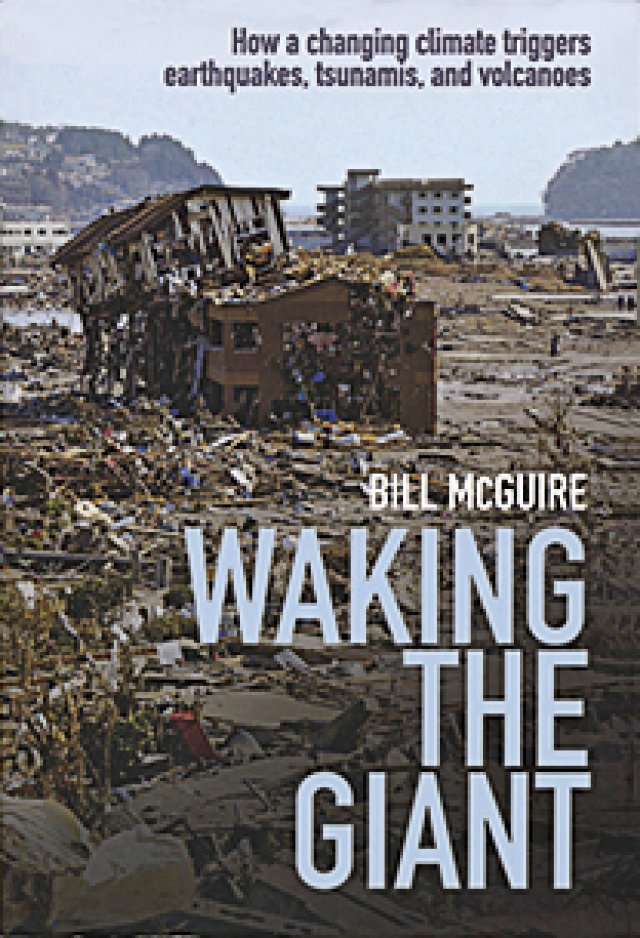
Waking the Giant: How a Changing Climate Triggers Earthquakes, Tsunamis & Volcanoes
Bill McGuire
Oxford University Press, 2012
303 pages, $35.95 (hb)
It is easy to forget, says Professor Bill McGuire of University College London in Waking the Giant, that human civilisation has thrived only in the broadly benign climate of the past few thousand years following the end of the last post-glacial era.
This spacious window of climatic and geologic calm, however, is closing well ahead of its allotted global freeze-thaw-cycle time as a result of human-caused climate change capable of compressing vast geologic eras into mere human generations.
Despite some “muddle-headed” cyber-speculation that anthropogenic climate change caused the devastating 2004 Indian Ocean and 2011 Japanese marine earthquake-tsunamis (which were driven by tectonic plate boundary forces alone), McGuire says there is well-established scientific evidence that global warming of the atmosphere interacts with the geosphere (the solid Earth).
This occurs through changes in the hydrosphere (sea-level rises from thermal expansion of the oceans and from melting polar and glacier ice), with potentially harmful consequences for the biosphere (humanity and other life forms) through more volcano, earthquake and tsunami action.
Volcanic activity is stimulated by global warming through the added weight of seawater stressing the Earth’s crust to trigger the expulsion of stored magma in “primed” volcanoes.
Primed volcanoes “teeter on the edge of stability” and are highly sensitive to even miniscule changes in the environment, such as tidal stresses, rainfall, annual variations in the shape of the planet and, especially, changes in the hydrological cycle.
A volcano eruption season (November to April) exists during which the wholesale redistribution of 1016 kilograms of the planet’s water is shifted between the two hemispheres during their respective winters, causing deformations at the Earth’s surface from the extra load exerted by lying snow, rainfall-recharged groundwater and a cooler, denser atmosphere.
The resulting crustal squash prompts primed volcanoes to blow their top in classic volcano fashion whilst increased ocean stress-loading also makes the flanks of volcanoes more prone to collapse with explosive decompression of magma.
Thinning ice also plays a role in increased earthquake activity. The bouncing back of the planet’s crust following extended glacial detention beneath thick ice allows long-subdued tectonic faults, kept in stasis by the weight of the ice, to rupture.
Ten thousand years after the end of the last Ice Age, the resulting changes in ice mass at that time still continue to trigger, or at least facilitate, earthquakes (especially in Alaska, the Andes and New Zealand).
The burst of post-glacial earthquakes in Canada and Europe provide testimony for a possible earthquake-prone future should the great, but shrinking, ice masses that now cover Greenland and west Antarctica go the same way as the ice sheets of the late Pleistocene.
If less ice weight is a causal mechanism for more earthquakes directly below the ice, so is the increased weight at the edges from the newly freed-up water (which weighs more than ice). At over 100 dam locations, the weight of reservoir water has been found to increase the risk of seismic activity through destabilising geological faults at the periphery.
This same principle will apply to the water released from polar ice caps, glaciers and permafrost by global warming.
With increased volcanic and seismic activity comes increased tsunami risk. The tsunami lethality of huge undersea earthquakes is well known but tsunamis can also derive from collapsing coastal or island volcanoes which are far from rare (around 20 a century) and likely to become less rare because such collapses show a “clear preference” for a warming world.
Unlike the geologist glove-puppets of the climate change denialist mining industry, McGuire sources peer-reviewed science. It ranges from long-established consensus to plausible conjecture. Scientific unknowns and hotly contentious research are recognised as such.
The geological science in McGuire’s book requires concentration, but his accessible presentation repays the effort.
With the advent of fossil fuel burning in the second half of the 20th century, says McGuire, “nature has”, for the first time in the history of our planet, “lost its role as the primary determinant of what is happening to our climate”. Therefore, “how we live and what we do in the next few decades” is crucial to the future of our world.
Will violent geological upheaval “compound all the other woes” of anthropogenic climate change?
If scientists like McGuire prevail, the worst may yet be avoided. If carbon-dirty profits prevail, then cataclysmic geological grief will be added to an already unappetising climate change agenda.
